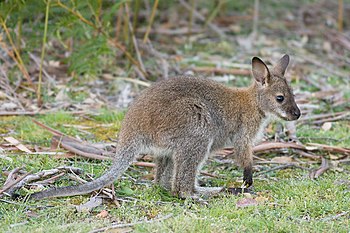Talk:Red-necked wallaby
| This article is rated Start-class on Wikipedia's content assessment scale. It is of interest to the following WikiProjects: | |||||||||||||||||||||||||||||||||||||||||||||||||||||||||
| |||||||||||||||||||||||||||||||||||||||||||||||||||||||||
odd line
[edit]As one of the largest wallabies, it can easily be mistaken for a kangaroo. - given that the line between something being a wallaby and a kangaroo is completely arbitrary in this genus, surely it is not mistaken for a kangaroo but sometimes considered one. Sabine's Sunbird talk 03:54, 12 August 2009 (UTC)
File:Macropus rufogriseus rufogriseus Juvenile 2.jpg to appear as POTD soon
[edit]Hello! This is a note to let the editors of this article know that File:Macropus rufogriseus rufogriseus Juvenile 2.jpg will be appearing as picture of the day on September 1, 2011. You can view and edit the POTD blurb at Template:POTD/2011-09-01. If this article needs any attention or maintenance, it would be preferable if that could be done before its appearance on the Main Page so Wikipedia doesn't look bad. :) Thanks! howcheng {chat} 19:11, 31 August 2011 (UTC)
File:Macropus rufogriseus rufogriseus Bruny.jpg to appear as POTD soon
[edit]Hello! This is a note to let the editors of this article know that File:Macropus rufogriseus rufogriseus Bruny.jpg will be appearing as picture of the day on July 20, 2012. You can view and edit the POTD blurb at Template:POTD/2012-07-20. If this article needs any attention or maintenance, it would be preferable if that could be done before its appearance on the Main Page so Wikipedia doesn't look bad. :) Thanks! —howcheng {chat} 18:12, 16 July 2012 (UTC)
Categorization
[edit]Grutness: please see WP:NONDEF: a defining characteristic is one that reliable, secondary sources commonly and consistently define, in prose, the subject as having. [...] if the characteristic would not be appropriate to mention in the lead portion of an article, it is probably not defining;
. Being a symbol of a county or other polity is certainly not a defining characteristics of an animal species, ergo it shouldn't be in the Category:Waimate District. Including the wallaby in a category of a New Zealand district certainly opens a can of worms — otherwise, imagine the number of potential categories at Lion or Eagle. Of course, I don't mind mentioning Waimate District in running text; if you can find more examples, maybe a new section like "Cultural significance" would be justified (compare Lion#Cultural significance). No such user (talk) 11:33, 26 April 2016 (UTC)
- It's a tricky one - it's not a defining characteristic of the wallaby, but it is a defining characteristic of Waimate District which, as I pointed out on your talk page, is widely referred to as "Wallaby country". It would be appropriate to mention Bennett's wallaby in the lede on Waimate District (although that article currently does not do so - it's in a later paragraph). However, I will bow to your opinion, given that similar examples are not so categorised (much to my surprise - I would have expected Barbary macaque to be in Category:Gibraltar, for instance). Grutness...wha? 12:23, 26 April 2016 (UTC)
- Thanks. Well, there is a reasonably detailed Barbary macaques in Gibraltar article which serves as a meeting point between the two categories, but I suppose it would be an overkill to apply the same approach for the wallabies and Waimate. No such user (talk) 14:44, 26 April 2016 (UTC)
- Start-Class mammal articles
- Low-importance mammal articles
- Start-Class Monotremes and marsupials articles
- Low-importance Monotremes and marsupials articles
- WikiProject Monotremes and Marsupials articles
- WikiProject Mammals articles
- Start-Class Australia articles
- Low-importance Australia articles
- Start-Class New South Wales articles
- Low-importance New South Wales articles
- WikiProject New South Wales articles
- Start-Class South Australia articles
- Low-importance South Australia articles
- WikiProject South Australia articles
- Start-Class Queensland articles
- Low-importance Queensland articles
- WikiProject Queensland articles
- Start-Class Tasmania articles
- Low-importance Tasmania articles
- WikiProject Tasmania articles
- Start-Class Victoria articles
- Low-importance Victoria articles
- WikiProject Victoria articles
- Start-Class Australian biota articles
- Low-importance Australian biota articles
- WikiProject Australian biota articles
- WikiProject Australia articles












